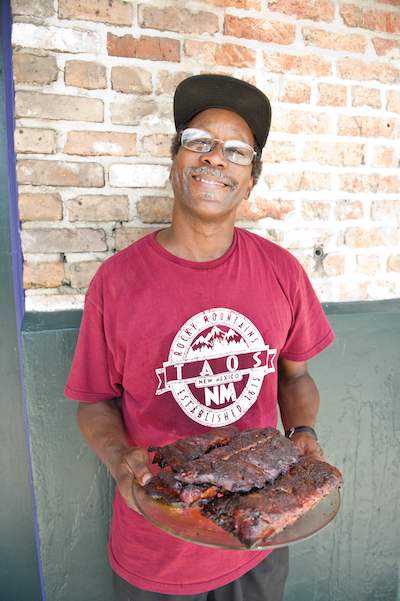“I’m not so much of a cooker as I am a smoker.
I smoke meats. I like anything from ribs to brisket to fish.
I smoked some spare ribs and some baby back ribs yesterday, and I finished them up today. I did them with a dry rub from my next-door neighbor, Mr. Michael Ruoss, who used to be the executive chef at Nola and now he’s at Salu. I get the ribs out. I put a thin layer of rub on and I let it sit for a while. Don’t marinate it. Sometimes I’ll marinate a brisket, but when I do ribs I don’t marinate at all. I let that rub stay on for about three, four hours, maybe five. And then, before I get ready to cook them, I drizzle them with some honey, and then I put another layer of rub on top of that, so I’ve got two layers of rub and some honey in the middle. Then I smoke them until the meat temperature is 165 degrees.
I use various woods. Today I used a combination of pecan and hickory. For about five pounds of meat, I used seven hours of smoking time.
What I use is a Brinkmann smoker; those are the best smokers you can get for the money. They’re around $35. They have a water pan, a pan for your charcoal, and it has two layers. You can smoke 15 pounds of meat.
All I do is smoke, pretty much. I was a cook for a long time, but my wife is a much better cook than I am. She does New Orleans stuff a whole lot better than I do, so I let her do that, but every now and then I’ll sauté up some fish, in butter and olive oil, or blacken it.
When it gets cold, I try to smoke a cheese, and this last year, I smoked a ham. I had a shoulder, and did a brine for about three days. Then I smoked it for 24 hours without breaking. I was waiting for it to get cold this year, but it never got real cold. What I wanted to do, and I’ll probably do it next year, is brine it for about two weeks. Put it outside in my laundry room at night and then smoke it for 36 hours. Last time I did it, wasn’t it good?
Smoke is a natural preservative. That’s what people used before refrigeration. That’s why you’ve got your smoked ham, your bacon and all of that. I use big wood chunks as opposed to chips, because it works better for me. It lasts longer, so you don’t have to worry about putting chips on every 10 minutes.
I soak the wood for about a day, so I’ll get a nice, low-heat thing. You’ve got to plan ahead and have a day with nothing to do, or you’re doing stuff around the house. I smoke according to my work schedule. I don’t have many days off when I have nothing to do, but I try to smoke at least three times a month.
I started off smoking trout. I’d catch trout, you know, rainbow trout, smoke them real quick. I graduated on to meat. When I lived in Kansas City for three years, that kind of bumped it up a notch. I started working some barbecue festivals and competitions. I started to get secrets from different guys. They’d say, “Come on; try this out, try that out,” “Try this rub, try that wet,” “Try this and that,” so I learned a lot from them about wets and dry rubs and temperatures. I helped my neighbor, he was in the pig thing [Hogs for the Cause] up in City Park and I told him to do the honey thing. He said, “Well, the rub has mustard,” and I said, “Yeah, honey mustard.” They got fan favorite.
Fish is real low heat and it doesn’t take any time, it takes about twenty minutes or so. Cheese even less.
I got a thermometer on the side of the smoker and I can kind of tell the temperature now by the smoke itself. For cheese, I do it preferably when it’s cold outside on the lowest heat.
For the water, here’s the main thing: I put in a little bit of red wine, a little bit of Worcestershire sauce, a little bit of olive oil, all in the water. Put the water over the heat, and then up on top I put the ribs. Some people say the water doesn’t affect the taste, but I think it does, especially if you put stuff in there. It’s a steam thing that keeps it from getting too hot, and it keeps the meats moist. That’s why these ribs are so moist. With the rub, you don’t need a sauce, or anything. The rub is flavorful enough.”
Dry Rub
This recipe comes from Chaz’ neighbor Michael Ruoss, chef at Salu, who plans on opening a barbecue restaurant.
1 tablespoon brown sugar
1 tablespoon ground ancho pepper
2 tablespoon paprika
1 tablespoon ground cumin
1/2 tablespoon cayenne
4 tablespoon kosher salt
1/2 tablespoon black pepper
1/2 tablespoon celery salt
1 tablespoon granulated garlic
1 tablespoon granulated onion
1/2 tablespoon dry mustard
Mix. Store in an air-tight container.





